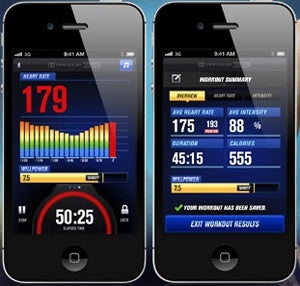A new system scheduled to be released this spring aims to take heart monitoring for athletes to the next level. Under Armour has announced Armour39, a chest-strap monitor that sits near the base of the sternum, measures heart rate, and syncs up to 16 hours of stored data via Bluetooth with a mobile devices or a separate display watch. The app for the system allows users to display heart rate in real-time and using this information, estimations of calories burned and intensity of workout are displayed.
On the surface, this appears to be just another heart monitor; however, the company claims that the difference is the introduction of a new metric: WILLpower.
The website describes that the algorithm to assess WILLpower combines the length and type of the workout, information like gender and weight, and specific heart rate measures to produce a single score from 0.0 to 10.0. The idea is that this score reveals how hard an athlete is training and can be used as a workout target.
Unlike previous systems from the sportswear company, Armour39 does not monitor breathing rate but Under Armour says it can also be worn all day to track calories burned continuously. Currently, the system is priced at $150 while the Armour39 watch sells for $200.
Here’s the video of the device:
Armour39 joins a list of new devices aimed at syncing with smartphones to provide more information about your body, including the Fitbit Zip. Now, monitors that measure calories burned also use a simple calculation based on heart rate, and Under Armour’s gauge of intensity level probably derives from standard heart rate assessments like resting, recovery, and maximum heart rates standardized to biometric information. The rate of change in heart rate can also be telling when assessing intensity.
But can these gauges actually translate into observable improvements in fitness?
One of the amazing things about the human body is its ability to adapt, made possible in part because of a metabolism that can shift to new norms. This helps keep everything running on the inside of the body stable. Unfortunately, metabolism can lock athletes in training into stasis points — fitness levels that the body resists deviating from — that are like tar pits to escape out of. Getting out of a plateau is not altogether a science, and often involves changing training styles completely. Armour39 may help to not only provide some kind of measure of being in the right zone of physical exertion, but it could also psychologically help an athlete by providing a target to strive for during challenging training days.

Admittedly, the WILLpower metric sounds a bit ominous and highly interpretative. It’s hard to imagine high degrees of accuracy with an algorithm that measures a single variable, so comparing the WILLpower from one person to the next could be completely meaningless. It appears that it is best suited as a relative gauge, one that helps you associate the difficulty of a workout to a number to create an experiential scale that gives the impression that it is scientific.
If Under Armour’s track record means anything, the system will likely experience great commercial success based on the popularity of the brand that has netted the company close to $2 billion in revenue last year.
Regardless, the idea of quantifying willpower along with a host of other measures will be key to the future of body monitoring. The day will come when a multitude of sensors collect massive amounts of data about your body and convert that into meaningful meters of health, whether you are an athlete or not. The body 2.0 era is approaching rapidly as a gold rush-like excitement is brewing about health monitoring for preventative medicine both as a way of having a healthier populace and also reducing skyrocketing healthcare costs that are becoming a severe burden on society.
Hopefully, Under Armour will continue its endeavors to produce smart athletic accessories that are popular and data rich. If it becomes hip to be swimming in data about what’s happening inside your body right now, then we’ll all benefit and live longer to boot.




